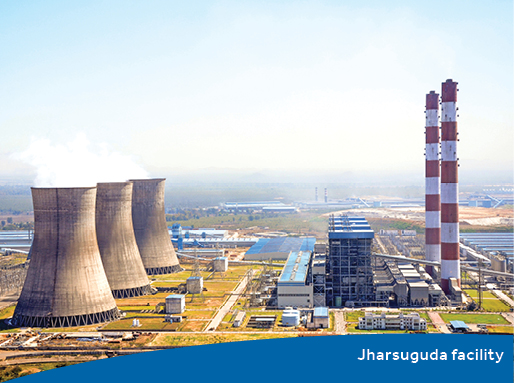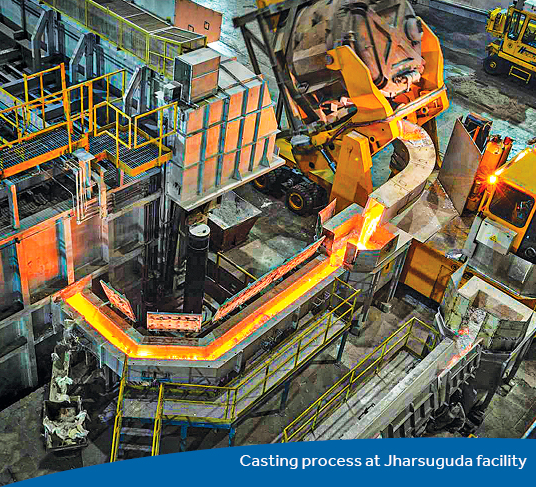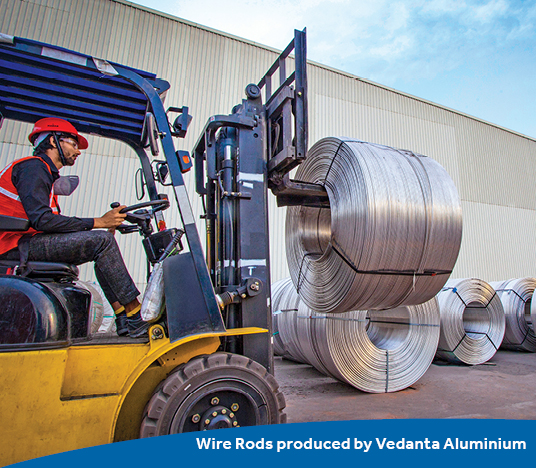THE YEAR IN BRIEF
In FY2021, the aluminium smelters achieved India’s highest production of 1.97 million tonnes (including trial run). It has been a remarkable year in our cost reduction journey on all operational fronts. Structural reforms and continued focus on operational excellence, coupled with lower input commodity prices, provided us a long-term cost advantage. Our efforts towards optimising our bauxite and coal mix and improved asset capacity utilisation across refinery, smelters and power plants supported the cost reduction journey. We started and continued a structural cost reduction programme called Vijaypath with focus on optimising our controllable costs and improving our price realisation to improve profitability in a sustainable manner. The hot metal cost of production for FY2021 stood at US$ 1,347 per tonne. We also achieved record production of 1.84 million tonnes at the alumina refinery through continued debottlenecking.
THE YEAR IN BRIEF
In FY2021, the aluminium smelters achieved India’s highest production of 1.97 million tonnes (including trial run). It has been a remarkable year in our cost reduction journey on all operational fronts. Structural reforms and continued focus on operational excellence, coupled with lower input commodity prices, provided us a long-term cost advantage. Our efforts towards optimising our bauxite and coal mix and improved asset capacity utilisation across refinery, smelters and power plants supported the cost reduction journey. We started and continued a structural cost reduction programme called Vijaypath with focus on optimising our controllable costs and improving our price realisation to improve profitability in a sustainable manner. The hot metal cost of production for FY2021 stood at US$ 1,347 per tonne. We also achieved record production of 1.84 million tonnes at the alumina refinery through continued debottlenecking.
OCCUPATIONAL HEALTH &SAFETY
We report with deep regret, two fatalities during the year, one at our operations in Lanjigarh during unloading of bauxite and another at the power plant in BALCO. We investigated both incidents thoroughly and shared the lessons learned across all our businesses.
This year, we experienced total 19 Lost Time Injuries (LTIs) at our operations with a LTIFR of 0.27.
To enhance competencies of our executives, engineers, and supervisors of business partners, we have launched the Safety Booster programme at our sites. We conducted safety stand-downs across the sites to communicate the learnings from safety incidents and prevent repeated future incidents. Also, our safety leadership regularly engages with the business partner site in-charges and their safety officers for their capability development and strengthening the culture of safety at our sites. Our operations commenced a monthly theme initiative where cross-functional audits and awareness programmes were carried out based on one high hazard work area each month such as confined space, vehicle driving and working at height.
Moreover, to sensitise our employees towards our core values of ‘Care’, we regularly carry out programmes such as ‘Suraksha ki Goth’ and ’Suraksha Charcha’.
The worldwide outbreak of COVID-19 has not impacted our operations in FY2021. As part of our Corporate Social Responsibility, our business units worked with the government and stakeholders, including local community to provide relief measures. Our mobile health units were used for creating awareness with a clear emphasis on the importance of social-distancing and maintaining personal hygiene. Our business units provided support to the district and state health services in terms of medical equipment, including hand sanitisers, medicines, reagents and PPEs such as surgical masks, gloves, gowns and personnel (housekeeping staff, security personnel, medical personnel and so on, in addition to the contribution to the government’s relief fund for COVID-19).
The SHGs associated with our facilities were involved in preparing masks, thereby creating livelihood while helping reduce the COVID-19 impact. Fire brigades at the facilities have been deployed to sanitise the premise and in the core villages near our facilities. The facilities provide food to migrant workers, identified community groups, police personnel and so on, as part of our social responsibility initiatives.
ENVIRONMENT
Jharsuguda has recycled 14.67%
of the water used in FY2021, while
BALCO has recycled 12.49%. One
of our smelters at Jharsuguda
has achieved Specific Water
Consumption of
0.28 m3/mt of
aluminium, a benchmark in India.
There has been a significant
improvement in our water
consumption of 0.59 m3/mt
(FY2020: 0.69 m3/mt) at BALCO.
We are consistently focusing on
improving the recycled water
percentage.
The management of hazardous waste such as spent Pot line, aluminium dross, fly ash, and so on are material waste management issues for the aluminium business. Our BALCO and Jharsuguda units disposed of 25,949 mt spent pot lining and 14,736 mt of aluminium dross this year, to recyclers authorised by respective state pollution control boards. Our operations were able to dispose 100% of fly ash generated at the units. At our Lanjigarh operations, 92% of lime grit has been utilised in FY2021 vis-à-vis 98.4% in FY2020.

PRODUCTION PERFORMANCE
| Particulars | FY2021 | FY2020 | % change |
|---|---|---|---|
| Production (kt) | |||
| Alumina – Lanjigarh | 1,841 | 1,811 | 2 |
| Total aluminium production | 1,969 | 1,904 | 3 |
| Jharsuguda I | 533 | 543 | (2) |
| Jharsuguda II1 | 867 | 800 | 8 |
| BALCO I | 265 | 256 | 4 |
| BALCO II | 304 | 305 | - |
(1) Including trial run production of 27 kt in FY2021 vs. nil in FY2020
ALUMINA REFINERY: LANJIGARH
At Lanjigarh, production was 2% higher y-o-y at 1.84 million tonnes, primarily through continued plant debottlenecking and improved capacity utilisation.
ALUMINIUM SMELTERS
We ended the year with production of 1.97 million tonnes (including trial run). Our smelter at BALCO continued to show consistent performance. Jharsuguda smelter ramped-up its production from 1.3 mtpa in FY2020 to 1.4 mtpa in FY2021, 4% up y-o-y.
COAL SECURITY
We continue to focus on the long-term security of our coal supply at competitive prices. We added Jamkhani and Radhikapur (West) coal mines through competitive bidding process by GOI. The Radhikapur Coal Block has a capacity of 6 mtpa, as per current approved mine plan and Jamkhani coal block is currently rated at 2.6 mtpa. These acquisitions will substantially improve our coal security. We also look forward to continuing our participation in linkage coal auctions and secure coal at competitive rates.

PRICES
| Particulars | FY2021 | FY2020 | % change |
|---|---|---|---|
| Average LME cash settlement prices (US$ per tonne) | 1,805 | 1,749 | 3 |
Average LME prices for aluminium in FY2021 stood at US$ 1,805 per tonne, 3% higher y-o-y. LME prices were bearish for the first two quarters due to pandemic-induced disruption in the global economic activity and seemed bullish in the last two quarters, driven by increase in demand in the second half of FY2021. The prices showed a sharp increase in the concluding months of FY2021.
UNIT COSTS
(US$ per tonne)
| Particulars | FY2021 | FY2020 | % change |
|---|---|---|---|
| Alumina cost (ex-Lanjigarh) | 235 | 275 | (15) |
| Aluminium hot metal production cost | 1,347 | 1,690 | (20) |
| Jharsuguda CoP | 1,304 | 1,686 | (23) |
| BALCO CoP | 1,450 | 1,700 | (15) |
During FY2021, the cost of production (CoP) of alumina improved to US$ 235 per tonne, due to benefits from increase in locally sourced bauxite, continued debottlenecking, improved capacity utilisation and plant operating parameters. This was further backed by reduced input commodity prices (mainly caustic soda and HFO).
In FY2021, the total bauxite requirement of about 5.3 million tonnes was met by Odisha (56%) and imports (44%). In the previous year, the bauxite supply mix was captive mines (9%), Odisha (49%) and imports (42%).
In FY2021, the CoP of hot metal at Jharsuguda was US$1,304 per tonne, down by 23% from US$1,686 in FY2020. The hot metal CoP at BALCO fell to US$1,450 per tonne, down by 15% from US$1,700 per tonne in FY2020. This was primarily driven by improved materialisation of domestic coal from Coal India Limited (CIL) with lower auction premiums and structural reduction in Renewable Purchase Obligation rates. Improved production and lower cost of Lanjigarh Alumina along with subdued input commodity prices in first nine months supported our cost reduction journey.
FINANCIAL PERFORMANCE
(` crore, unless stated)
| Particulars | FY2021 | FY2020 | % change |
|---|---|---|---|
| Revenue | 28,644 | 26,577 | 8 |
| EBITDA | 7,751 | 1,998 | - |
| EBITDA margin | 27% | 8% | - |
During the year, revenue increased by 8% to `28,644 crore, driven primarily by rising LME aluminium prices and higher production volumes. EBITDA was significantly up at `7,751 crore (FY2020: `1,998 crore), mainly due to improved hot metal cost of production and increased sales realisation.
STRATEGIC PRIORITIES & OUTLOOK
With the increasing primary aluminium demand, the outlook for FY2022 is strong. Regional ingot and value-added product premiums are rapidly increasing, reflecting a combination of low ordering for 2021 and stronger than expected demand.
The input commodity prices across carbon are moving on a higher side driven by continued demand increases. We are looking at ways to continuously optimise our costs, while also increasing the price realisation to improve profitability sustainably.
India’s market is expected to have robust growth, supported primarily by growing industrial activity and government focus on infrastructure sector and domestic manufacturing in the country. Several government initiatives (Make in India, Production-linked Incentive for domestic manufacturing, National Infrastructure Pipeline and National Rail Plan) will enhance aluminium demand, going forward.
Vedanta continues to expand its value-added product portfolio in line with evolving market demand, making it poised to grow in the Indian aluminium market.

At our power plants, we are also working towards reducing gross calorific value (GCV) losses in coal as well as improving plant operating parameters which should deliver higher plant load factors (PLFs) and a reduction in non-coal costs. Vedanta is working out a plan to expedite operationalisation of Radhikapur and Jamkhani coal mines.
Whilst the current market outlook remains bullish, our core strategic priorities include: